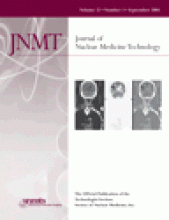Abstract
After 131I radioablative treatment, a 51-y-old woman underwent whole-body 131I scanning, which revealed intense uptake along the periphery of the skull. The patient disclosed that she had not washed her hair because she had obtained a new hairstyle between the 131I treatment and the scan. The intense uptake along the periphery of the skull represented radioactive physiologic accumulation at the patient’s scalp.
The specificity of 131I whole-body scans for detecting residual or recurrent local and metastatic disease is generally reported to be greater than 90% (1). However, in failing to recognize physiologic accumulation from perspiration, as in the following case, and other potential contamination artifacts and physiologic variants, the specificity is further compromised and often leads to unwarranted examinations and additional radiation exposure.
CASE REPORT
A 51-y-old African-American woman with a history of metastatic papillary thyroid cancer had undergone surgical resection of the tumor, external-beam radiation therapy for residual local disease, and treatment with 2 radioablative doses of 131I. The patient had been doing well, and her thyroglobulin levels had been stable. Because of a recent thyroglobulin increase, a whole-body 131I scan was ordered to identify any residual disease. Tracer uptake in the neck suggested local recurrence (Fig. 1). Subsequently, radioablative treatment with 5.55 GBq of 131I was given.
Anterior view of skull from whole-body 131I scan. Uptake is present in the region of the thyroid bed.
Ten days after treatment, the patient returned for a whole-body scan to better identify any other recurrences or metastatic disease. In addition to uptake at the thyroid bed, increased uptake along the periphery of the skull was present (Fig. 2). Upon questioning, the patient revealed that between the 131I treatment and the scan, she had not washed her hair because she wished to preserve the hair extensions she had placed. The patient stated that rather than washing her hair, which would disturb the hair extensions weaved into her own hair, she applied a petroleum-based jelly to the scalp to prevent drying. Presumably, this application caused perspiration to collect along her scalp within the hairline and produced the intense uptake of tracer seen along the periphery of the skull.
Anterior view of skull after 131I treatment. Diffuse uptake is present along the periphery of the skull.
DISCUSSION
The scope of false-positive findings after radioiodine treatment has been well documented (1–12). Such findings are primarily physiologic, being secondary to uptake in tissues that can concentrate 131I but do not retain it in organic form (11). Diffuse hepatic uptake due to the metabolism of radioiodinated thyroid hormones in the liver, as well as salivary and intestinal activity, is commonly seen (11). Contamination of the patient’s personal items, such as perspiration on jewelry or nasal secretions on a handkerchief, is reported less often but represents a very real pitfall for accurate interpretation of whole-body 131I images (1,3–12). In our case, the patient history, the knowledge of 131I artifacts, and the atypical location and distribution of the uptake all served to identify the abnormal tracer uptake as a physiologic variant.
Footnotes
For correspondence or reprints contact: Bohdan Bybel, MD, Department of Molecular and Functional Imaging, Cleveland Clinic Foundation, 9500 Euclid Gb3, Cleveland, OH 44195
E-mail: bybelb{at}ccf.org









